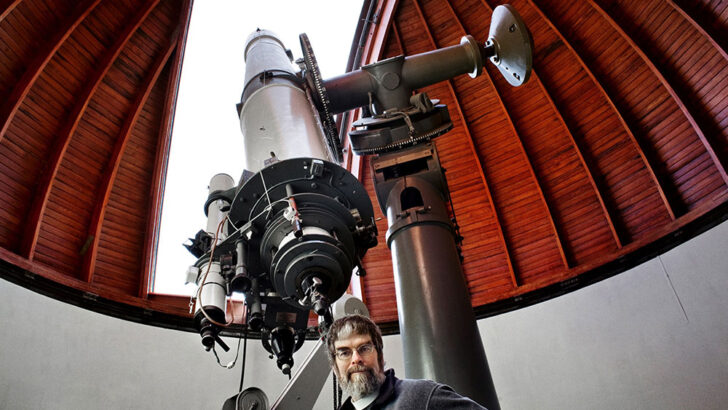Copernicus and the “Galileo case” are still taught in schools today. They drove a wedge of mistrust between the Church and science. But it was also a Catholic priest who first heard the bang.
“In the beginning, God created heaven and earth. But the earth was desolate and empty (…), and God’s Spirit hovered over the waters.” This is how the beginning of the world is described in Genesis, the first book of the Bible. The fact that this account of creation is not a scientific treatise, but rather a testimony of faith that is more than 2,500 years old, has got around outside the creationist doctrine. To this day, the Church is accused of being hostile to science. But it was a Catholic priest, of all people, who developed the counter-theory of the “Big Bang”: the Belgian Georges Lemaitre (1894-1966). His legacy is the focus of an international conference taking place from Sunday to Friday (16 to 21 June) at the Vatican Observatory in Castel Gandolfo.
The most important insight of this astrophysicist and theologian is as simple as it is obvious: the universe has its origin in time. If galaxies are constantly drifting apart, then they must have been closer together in the past. And this suggests that much earlier, the entire universe must have been concentrated in a single point: the “primordial atom”, which “exploded at the moment the universe was created”. Lemaitre assumed that the recently discovered red shift of stellar nebulae was not the result of the movement of galaxies in space, but rather the expansion of the universe itself.
The young professor published his ideas in 1927 in a little-known Belgian scientific journal – two years earlier than the US researcher Edwin Hubble (1889-1953), who is now generally credited with discovering the expansion of the universe. Lemaitre did not translate his essay into English until 1931.
‘Hubble-Lemaitre law’
However, he omitted the actually decisive passages on the expansion of the universe because, in his opinion, Hubble had already explained these ideas more precisely in 1929 – which later became famous as the “Hubble constant”. The priest-physicist never claimed his own copyright. Nevertheless, in 2018 the International Astronomical Union decided to rename the “Hubble Law” the “Hubble-Lemaitre Law”.
Lemaitre’s answer to the question of who might have triggered this primal impulse was that of the theologian”
Born in Charleroi, Wallonia, the Jesuit student Lemaitre wanted to become both a priest and a researcher from an early age. However, his ambitions were initially interrupted by his deployment on the front in the First World War. In addition to theology at the Mechelen seminary, he then studied maths and physics in Leuven and obtained his doctorate in 1920.
His many talents led to the next steps in rapid succession: ordination to the priesthood in 1923; further studies in stellar astronomy at Cambridge in 1924; professorship in Leuven in 1925; further doctorate at the Massachusetts Institute for Technology in 1927. Pius XII (1939-1958) admitted Lemaitre to the Pontifical Academy of Sciences at the end of 1940.
His faith in God was not shaken by his findings. And so Lemaitre’s answer to the question of who might have triggered this primal impulse was that of the theologian. This also appealed to and made sense to the Pontifical Academy, which recognised his theory in 1951. Pius XII explained that the beginning of the world, which can be dated to the “Big Bang” – around 13.8 billion years ago according to current knowledge – originated from an act of creation by God.
Divine creation?
However, it was precisely this interpretation that made the “Big Bang” theory so difficult to digest for Lemaitre’s critics: it was far too close to the biblical idea of the divine creation of the world, and also had the inexplicable uniqueness (“singularity”) of a “primordial atom”. It is said that the Belgian only managed to convince Albert Einstein (1879-1955) years later during a trip to California.
Today, an asteroid in the “main belt” between the orbits of Mars and Jupiter is named after him, as are a lunar crater and a transport vehicle to supply the International Space Station (ISS). He probably deserved more”
It was only after Lemaitre’s retirement in Leuven in 1964 that the final proof of the accuracy of the Big Bang theory was provided. The two young astrophysicists Arnold Penzias and Robert Wilson discovered the incidence of constant weak radio waves on the earth in Holmdelb/New Jersey in 1965. Cosmic background radiation; a noise, an echo of the once derided “Big Bang”.
Lemaitre died in Louvain in June 1966 at the age of 71. Today, an asteroid in the “main belt” between the orbits of Mars and Jupiter is named after him, as are a lunar crater and a transport vehicle to supply the International Space Station (ISS). He probably deserved more.


 US Jesuit Brother Guy Consolmagno, director of the Vatican Observatory is pictured at the observatory in Rome in 2007. Photo: CNS/Annette Schreyer
US Jesuit Brother Guy Consolmagno, director of the Vatican Observatory is pictured at the observatory in Rome in 2007. Photo: CNS/Annette Schreyer